Chemistry and Chemists № 1 2024
Journal of Chemists-Enthusiasts
| Content | Chemistry experiments - video | Physics experiments - video | Home Page - Chemistry and Chemists |
|
Chemistry and Chemists № 1 2024 Journal of Chemists-Enthusiasts |
Vegetable oil, ethanol and water (formation of emulsion) - part 3, 4 V.M. Viter |
|
Having noticed a mistake in the text, allocate it and press Ctrl-Enter
Sunflower oil, ethanol and rhodamine (fluorescence in UV) - part 3
Let us begin the fluorescence experiment. Typically, when capturing fluorescence or luminescence, I position the luminous substance in front of the camera and place the ultraviolet lamp BEHIND the camera. Occasionally, the ultraviolet lamp is positioned over the sample. However, I attached an ultraviolet lamp before the camera in this experiment. Then, I placed a test tube containing the rhodamine solution between the lamp and the camera. The described method differs from my usual approach, as I seldom recorded the experiment in this manner before.
Подсолнечное масло, спирт и родамин (флуоресценция в УФ) - ч.3 I turned on the lamp and immediately saw a bright yellow glow of the rhodamine solution. The test tube with the luminous solution stood out even in a lit room against the background of an ultraviolet lamp, which also produces dim light in the visible part of the spectrum. I illuminated the test tube from above - a bright yellow glow appeared again. In the video, the glow looked yellow with a greenish tint, but it seemed to me that the colour was pure yellow. Unfortunately, the perception of colours and shades can differ significantly from person to person. Also, I should mention the fact that cameras and monitors sometimes significantly distort colour reproduction. During trial experiments, I held a test tube with a rhodamine solution with my hand. Of course, later, the test tube had to be attached to a retort stand to get a high-quality video. In some cases, I placed an ultraviolet lamp in front of the camera (the lamp rays directly hit the lens); in other cases, I mounted the lamp behind the camera (as was in many previous experiments). Different people have different tastes and preferences, but I really like experiments with fluorescence and luminescence. I am more interested in experiments with explosions and combustion only. Therefore, I hope to continue experiments |

Ethanol, water and rhodamine (fluorescence in UV) |
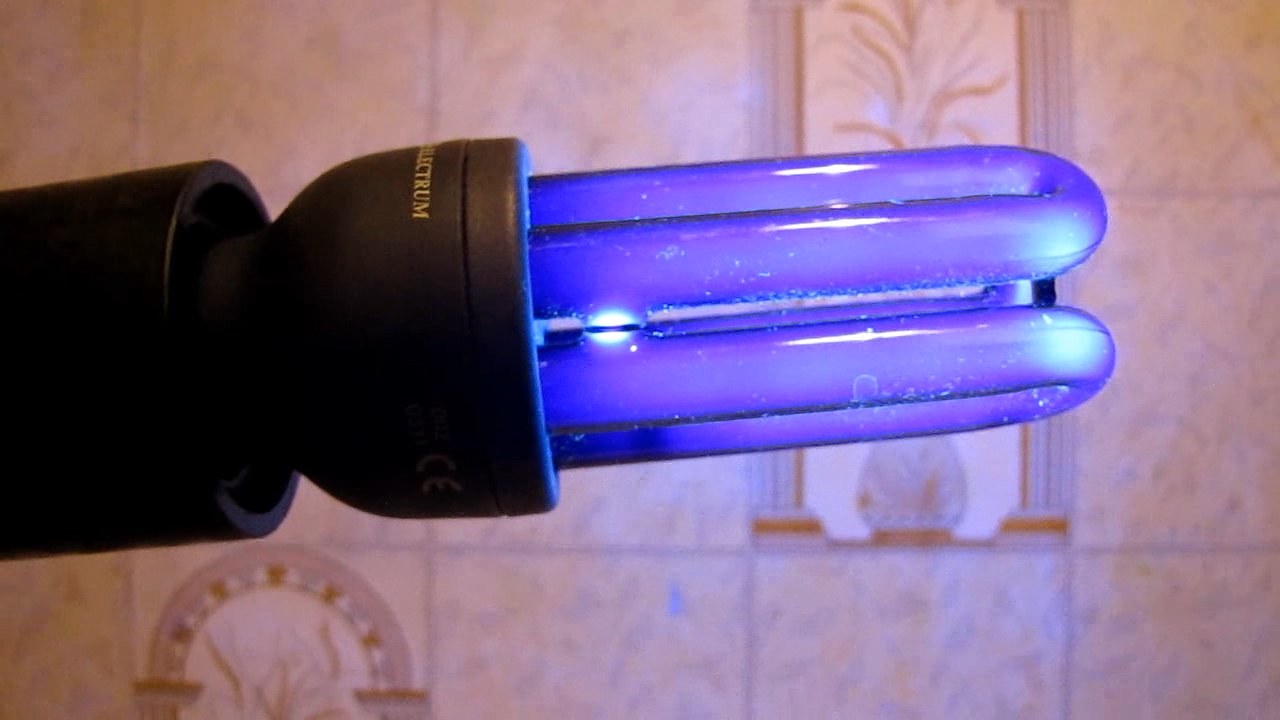
|
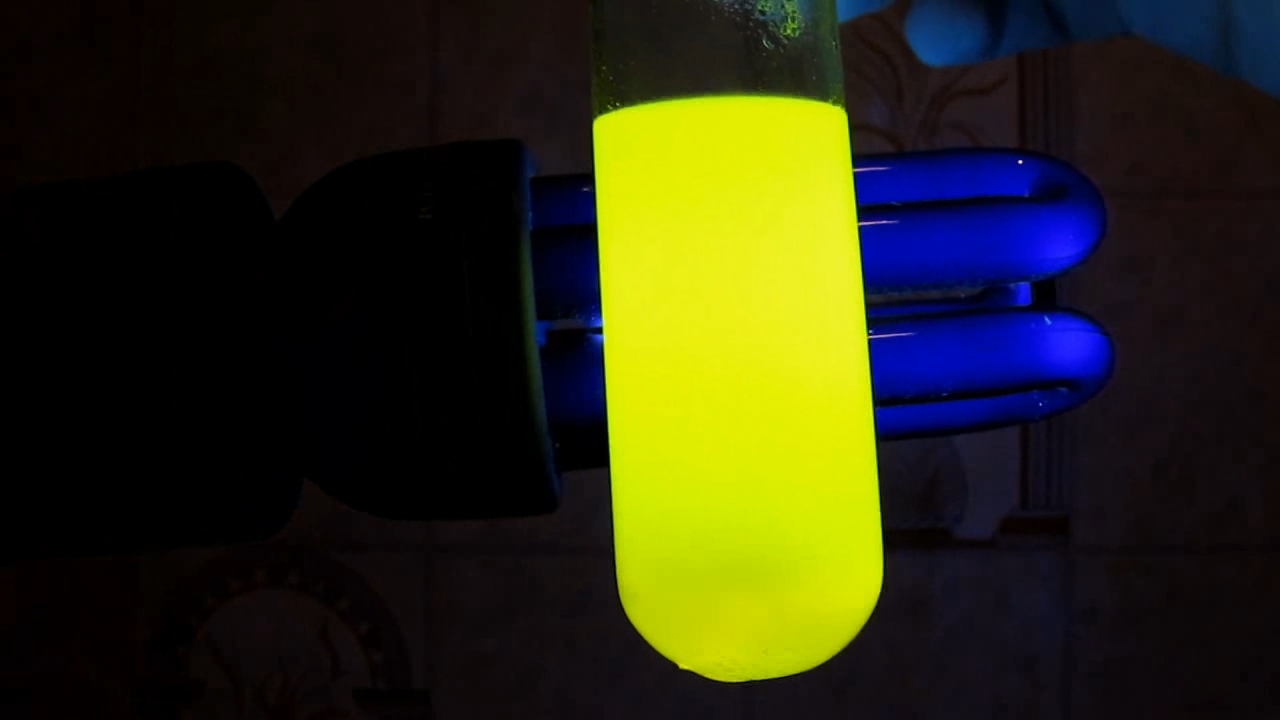
|

|

|

|

|

|
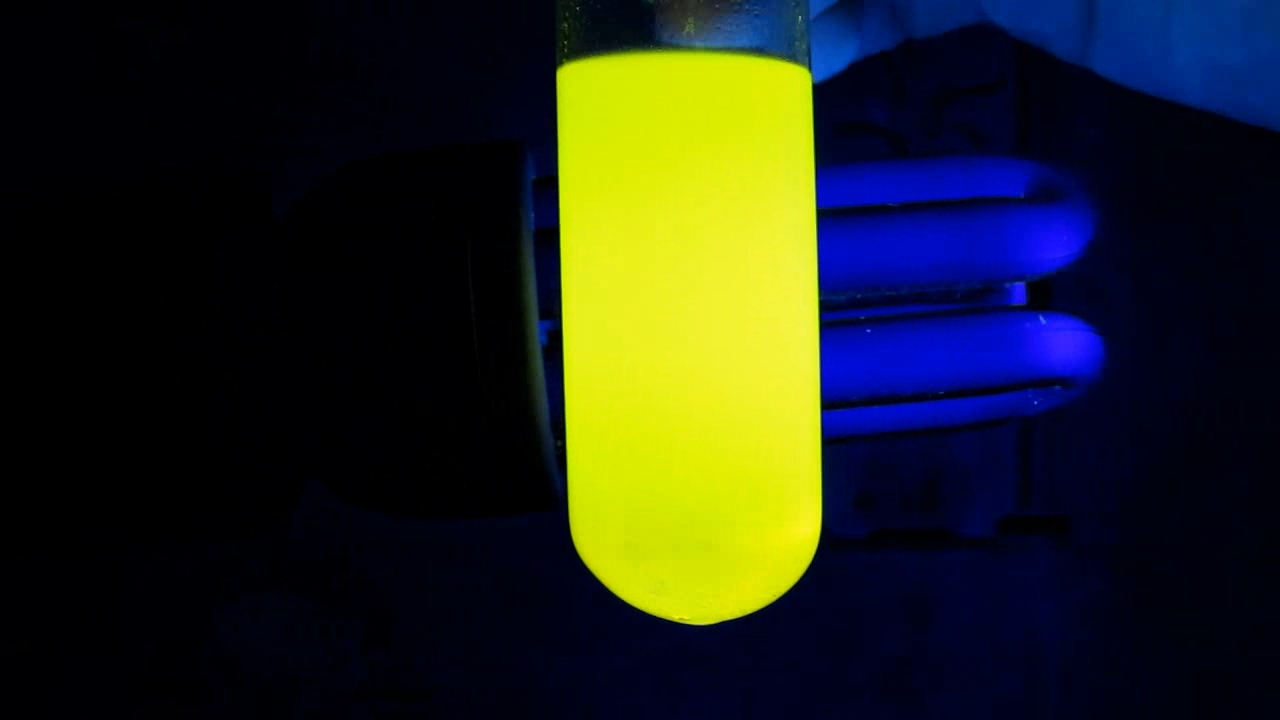
|

|
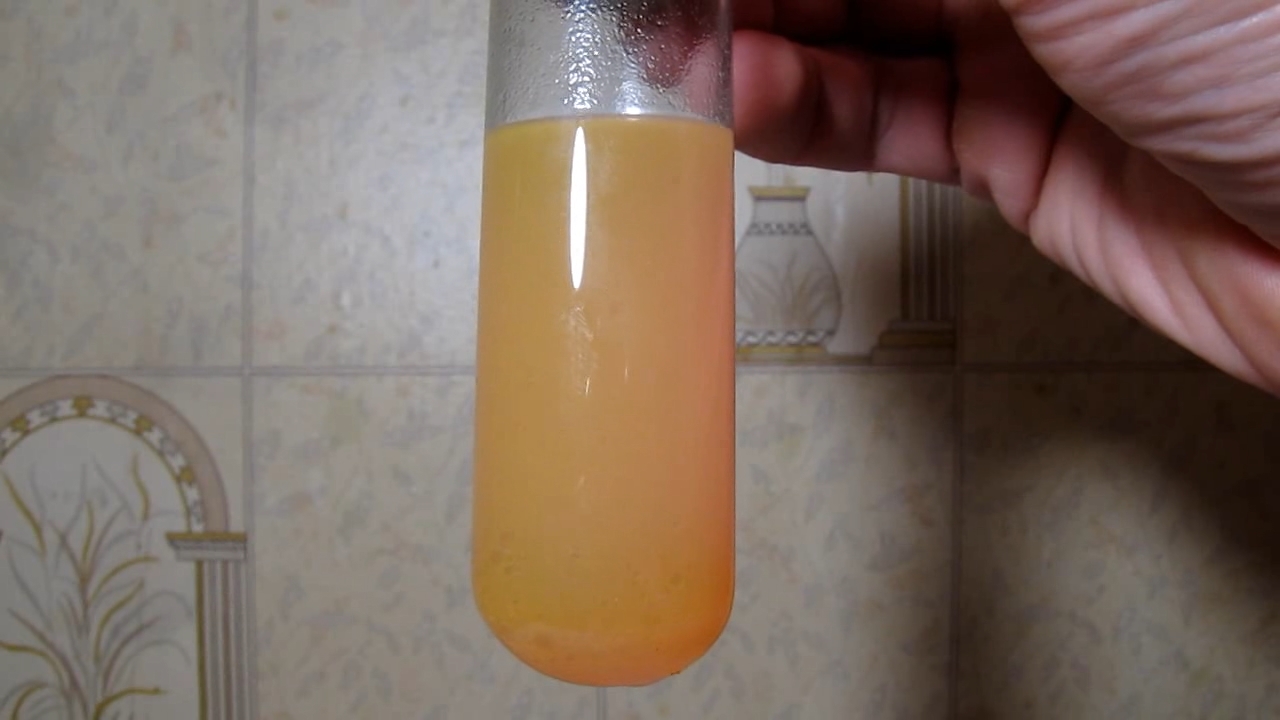
|

|
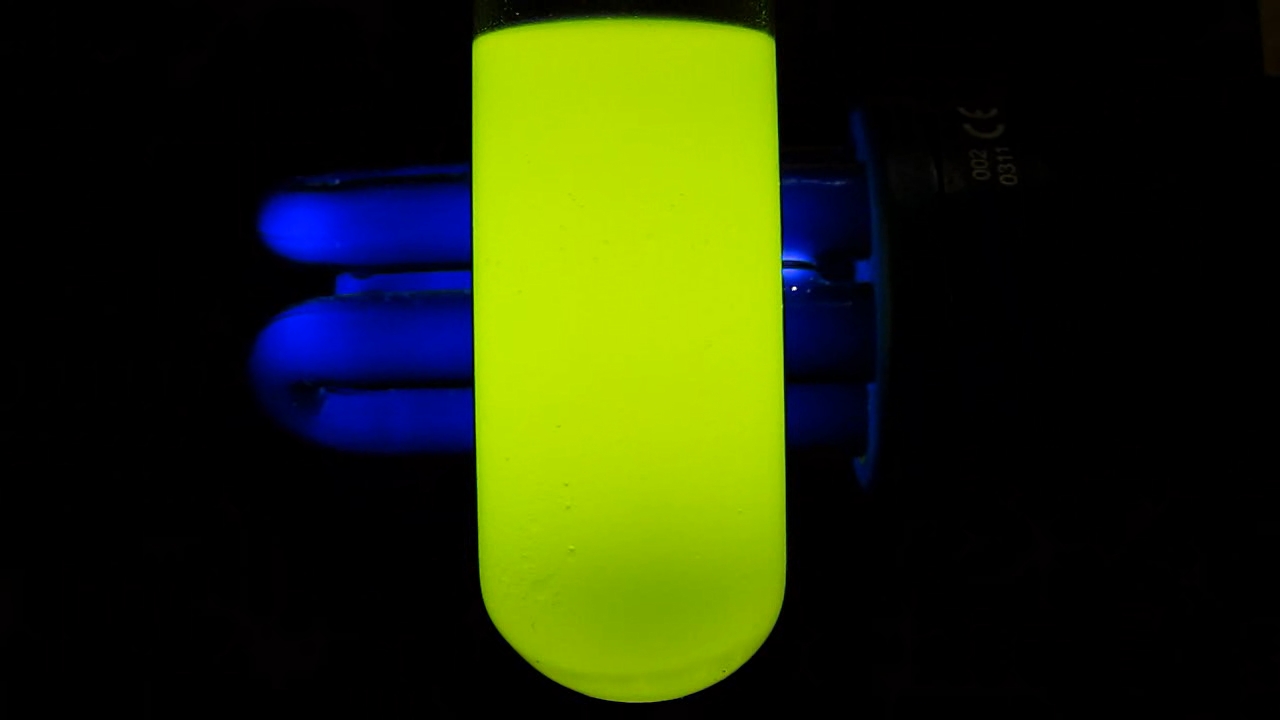
|

|
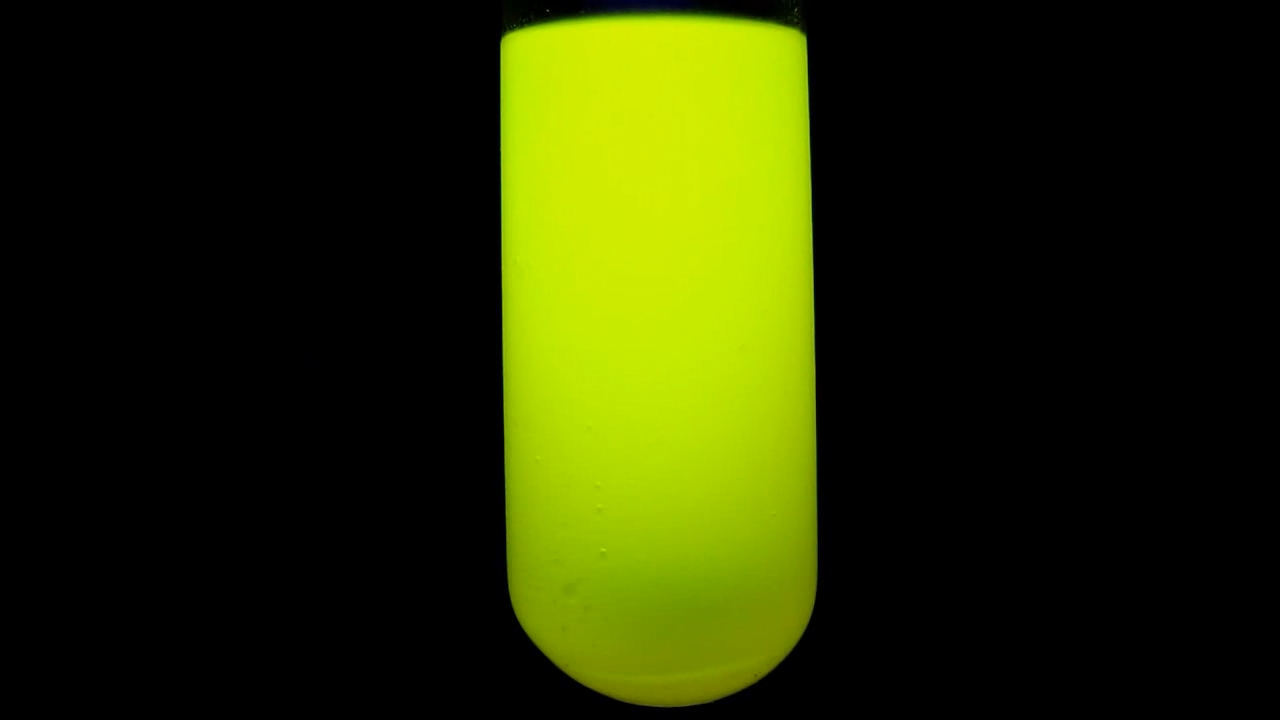
|

|
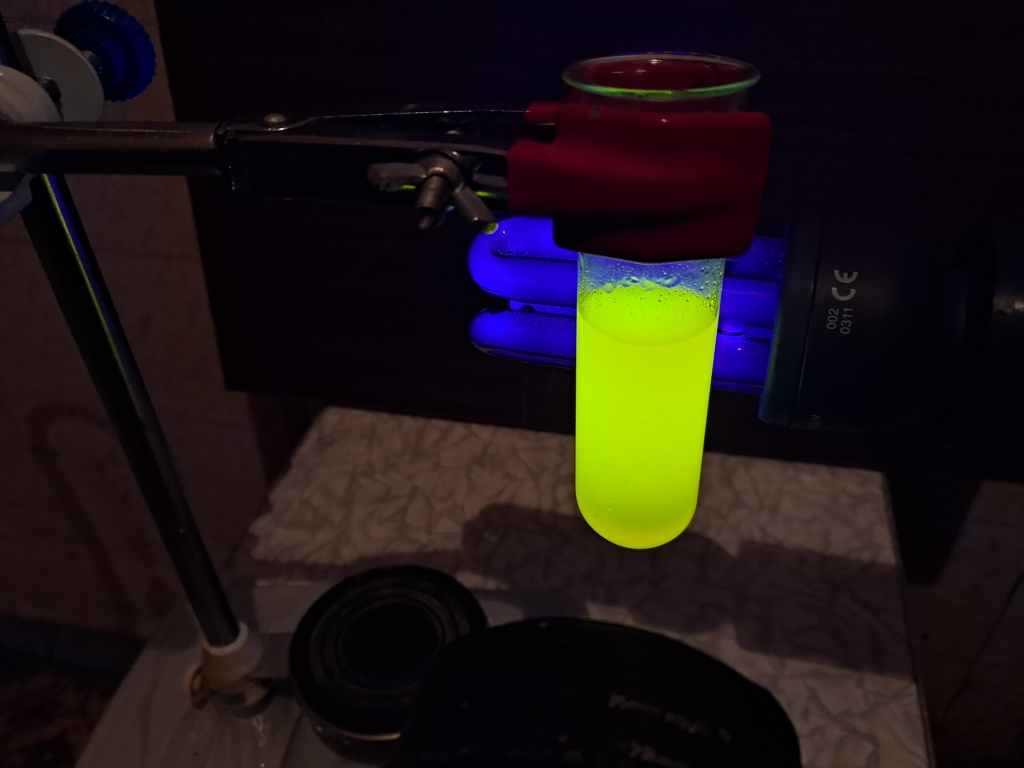
|

|
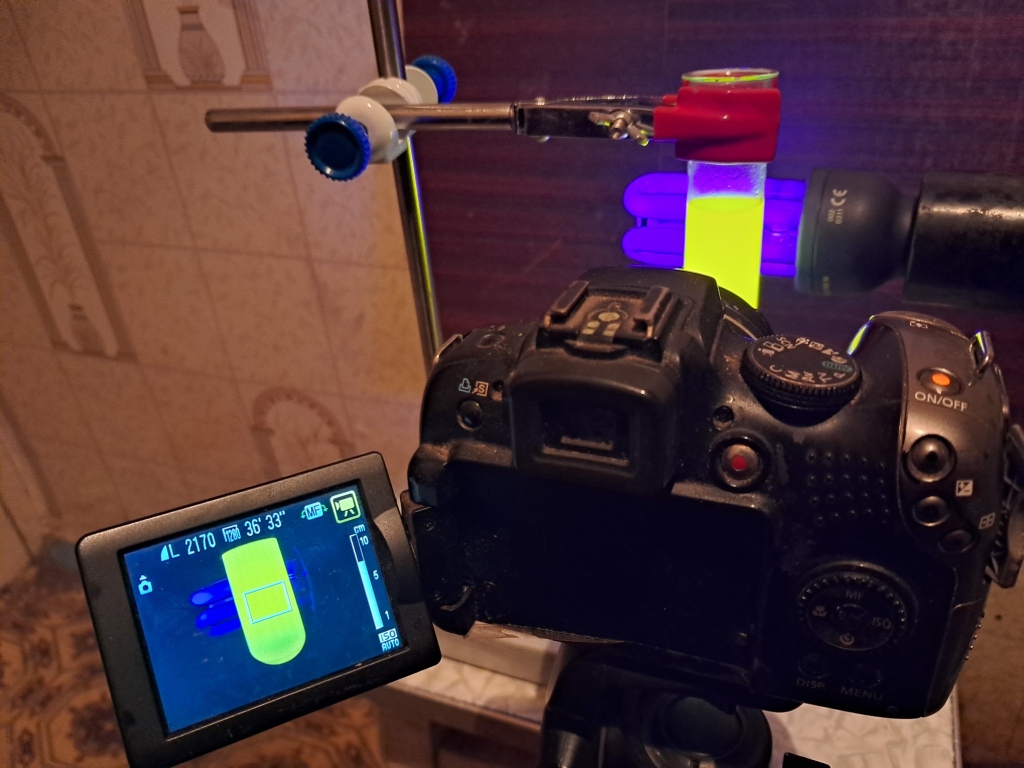
|

|
|
Sunflower oil, alcohol, rhodamine and green laser - part 4
So, in the test tube, there is a solution of rhodamine in a mixture of water and alcohol. This test tube also contains sunflower oil. Most of the oil formed a compact layer at the bottom, but some oil was dispersed in the aqueous-alcohol phase, forming an emulsion. I decided to pass a laser beam through the emulsion to observe the Tyndall effect. The result was a little unexpected. Now, let us talk about everything in order.
Подсолнечное масло, спирт, родамин и зеленый лазер - ч.4 Many years ago, the colleague, Monya Kvasov, posted photographs of a green laser beam passing through an aqueous solution of rhodamine on the forum. "I observed an interesting phenomenon. If you direct a green laser into a solution of rhodamine B, the dye fluoresces intensely with orange light. Using ordinary ("non-laser") green light, I was unable to achieve visible fluorescence. I do not know the reason for this effect. I assume that rhodamine fluoresces due to the high intensity of the radiant flux in the laser beam, which emits at a specific wavelength falling within the absorption band of the dye. Photos |
|
I tested fluorescein with a green laser - it does not exhibit its emitting properties (fluorescence) in any way in a green laser beam.
A blue laser must excite fluorescent dyes by its nature. The experiment can be carried out without a laser also. You can use violet LEDs or a "black light bulb" (compact fluorescent UV lamp). If you have limited access to chemical reagents, the easiest way to obtain a solution of the desired dye is by soaking the core of a fluorescent marker pen. Industrial pigments for markers are well excited by violet LEDs, and by the light of a "black light bulb", they glow no worse than the phosphor from visible light lamps. You can even make "glowing walls" that will illuminate the room. Here is another photo of the glow of rhodamine B, only this time in the long-wave ultraviolet light of a fluorescent lamp. I like this dye; its colour is so intense, bright and glowing, like a ripe berry." Photos |
|
Флуоресцеин я проверял зеленым лазером, - он никак не проявляет свои излучающие свойства (флуоресценцию) в зеленном луче лазера.
Синий лазер по природе своей должен возбуждать свечение флуоресцентных красителей. Опыт можно поставить и без лазера, - с фиолетовыми светодиодами или с "лампой черного света" (компактной люминесцентной УФ лампой). Если доступ к химическим реактивам у вас ограничен, проще всего получить раствор нужного красителя, вымочив сердцевину флуоресцентного маркера или фломастера. Промышленные пигменты для маркеров хорошо возбуждаются фиолетовыми светодиодами, а в лучах "лампы черного света" они сияют не хуже люминофора ламп видимого света. Буквально можно делать "сияющие стены", которые будут освещать помещение. Вот еще фотка свечения родамина Б, только на этот раз в длинноволновом ультрафиолете люминесцентной лампы. Нравится мне этот краситель, цвет его такой интенсивный, яркий, светящийся и вкусный, как спелая ягодка." |
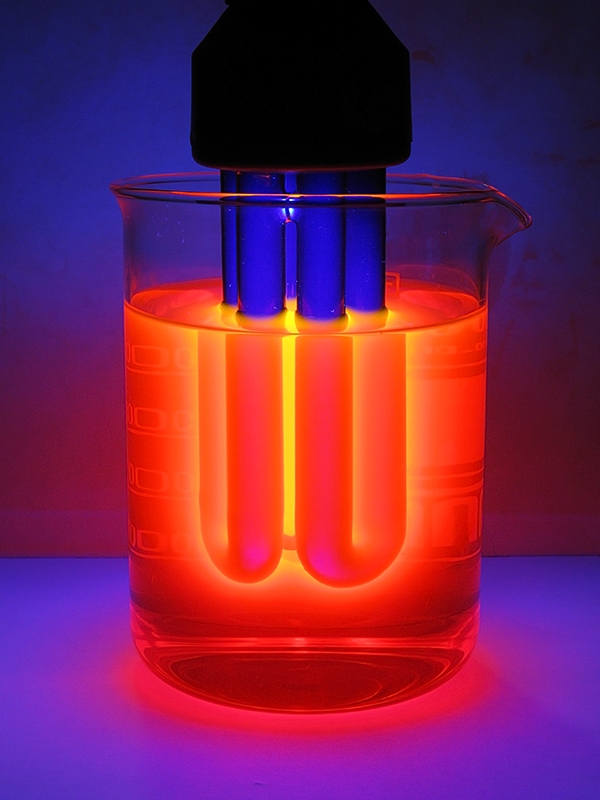
Rhodamine B solution in UV light / Раствор родамина Б в УФ-свете |
|
The colleague conducted the described experiment many years ago. During this time, I managed to forget about this experiment. Starting my experiments with rhodamine, I only remembered that similar work had been done by one of the forum members. Therefore, my prediction did not take into account the results described above.
What did I expect? When I direct a laser beam into the test tube with an aqueous-alcohol solution of rhodamine, the Tyndall effect will be observed (similar to that shown in the previous parts of the article). After all, the solution contains dispersed droplets of oil. The laser beam that passes through the emulsion should appear as a green line or cone of light as the dispersed particles scatter the light. Given the presence of rhodamine in the solution, yellow fluorescence should also be expected. My prediction turned out to be wrong. Even if I had read the description of my colleague's experiment again, it would not have helped me to predict the result. So, I directed a green laser beam to the test tube with the water-alcohol solution of rhodamine containing tiny droplets of oil. A bright yellow glow was observed where the laser penetrated the liquid. The glow had the shape of a cut sphere (spherical segment). The bulk of the solution had the same colour (it was bright yellow). However, the main part of the solution glowed much less intensely than the mentioned sphere. I think it was diffused light. Neither a luminous line nor a cone was observed in the liquid. In other words, the laser beam did not penetrate deeply into the liquid. In the colleague's experiment mentioned above, a green laser beam passed through an aqueous solution of rhodamine. In the case of an oil emulsion (similar to ours), which did not contain rhodamine, the laser beam passed through also. In both liquids, a luminous line (or cone) was visible. In the aqueous solution of rhodamine, the green laser beam appeared yellow-orange due to the dye fluorescence; in an uncoloured oil-in-water emulsion, the beam was green (the colour of the incident laser beam). Why is my result so different from my colleague's? There are many possible reasons. The dyes in our experiments were similar in structure but not identical. The solvents were also different. I used an aqueous-alcoholic solution of Rhodamine G, and the colleague used an aqueous solution of Rhodamine B. The concentration of rhodamine solutions could significantly differ in our experiments. Also, in my experiment, the dispersed oil particles scattered the light (the liquid was an emulsion, not a homogeneous solution). When I started looking for a possible explanation on the Internet, I accidentally found a photo on Wikipedia. It shows a green laser aimed at a solution of rhodamine G in methyl alcohol. The result was a yellow glow similar to that observed in my experiment. |
|
Описанный эксперимент коллега провел много лет назад. За это время я успел о нем забыть. На момент проведения экспериментов с родамином я помнил, что подобный эксперимент когда-то делал один из участников форума, но не более того. Поэтому мой прогноз не учитывал приведенные выше результаты.
Что я ожидал? Когда направлю луч лазера в пробирку с водно-спиртовым раствором родамина, будет наблюдаться эффект Тиндаля (аналогичный показанному в предыдущих частях статьи). Ведь раствор содержит диспергированные капельки масла. Луч лазера, который проходит через эмульсию, должен выглядеть, как светящаяся линия или конус зеленого цвета, поскольку дисперсные частицы рассеивают свет. Учитывая наличие в растворе родамина, следовало также ожидать желтой флуоресценции. Мой прогноз оказался ошибочным. Даже, если бы я снова ознакомился с описанием эксперимента коллеги, это бы не помогло предвидеть результат. Итак, я направил луч зеленого лазера на пробирку с водно-спиртовым раствором родамина, содержащим мельчайшие капельки масла. В месте, где лазер проникал в жидкость, наблюдалось яркое желтое свечение. Свечение имело форму срезанной сферы (сферический сегмент). Основной объем раствора имел тот же цвет (он был ярко-желтым). Однако, большая часть раствора светилась намного менее интенсивно, чем упомянутая сфера. По-видимому, это был рассеянный свет. Ни светящегося луча, ни конуса в жидкости не наблюдалось. Другими словами, глубокого проникновения луча лазера в жидкость не произошло. В упомянутом эксперименте коллеги зеленый луч лазера прошел через водный раствор родамина насквозь. В случае эмульсии масла (аналогичной нашей), которая не содержала родамина, лазерный луч также проходил насквозь. В обоих случаях в жидкости был виден светящийся луч (или конус). В водном растворе родамина зеленый луч лазера выглядел желто-оранжевым по причине флуоресценции красителя; в неокрашенной эмульсии масла в воде луч выглядел зеленым (цвет падающего луча лазера). Почему мой результат так отличается от результата коллеги? Возможных причин много. Красители в наших опытах были близкие по строению, но не идентичные. Разными были и растворители. Я использовал водно-спиртовой раствор родамина Ж (Rhodamine G), а коллега - водный раствор родамина Б (Rhodamine B). Концентрация родамина в наших экспериментах могла сильно отличаться. Кроме того, в моем эксперименте диспергированные частицы масла рассеивали свет (жидкость представляла собой эмульсию, а не гомогенный раствор). Когда стал искать возможное объяснение в интернете, случайно нашел фотографию в Википедии. На ней показан зеленый лазер, направленный в раствор родамина Ж в метиловом спирте. В результате возникло желтое свечение, аналогичное тому, которое наблюдалось в моем эксперименте. |

Sunflower oil, alcohol, rhodamine G and green laser |
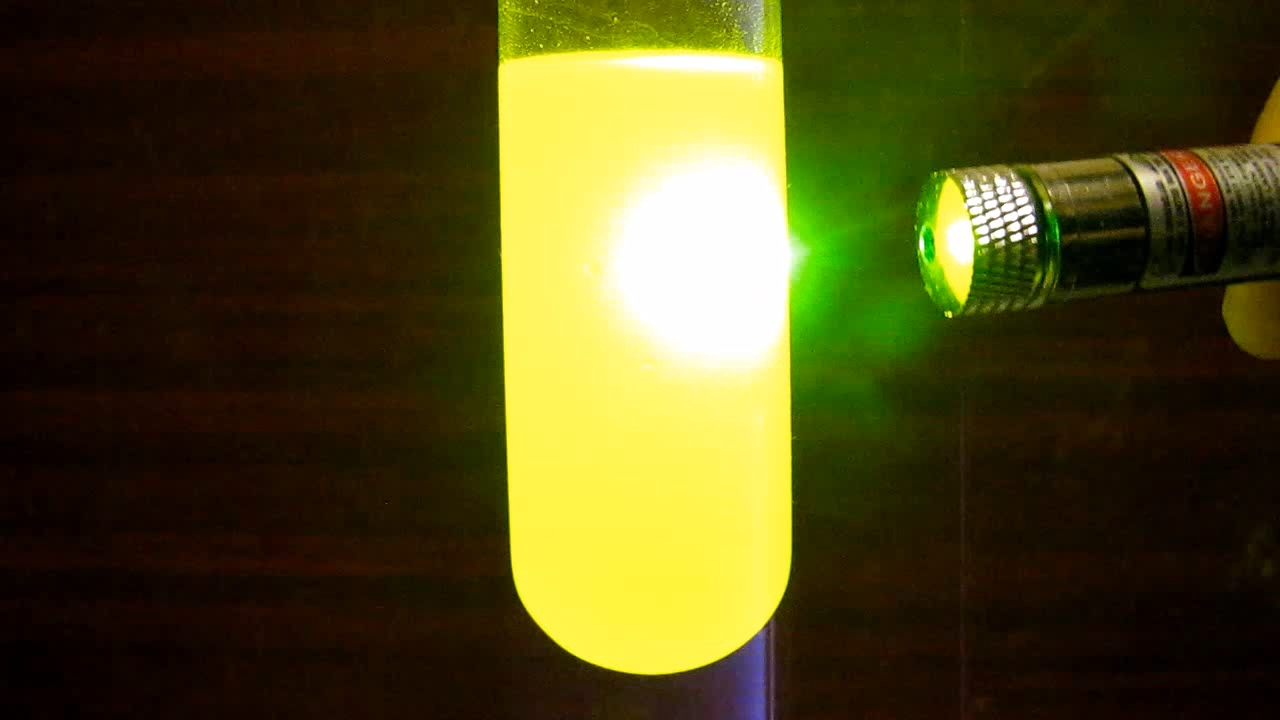
|

|
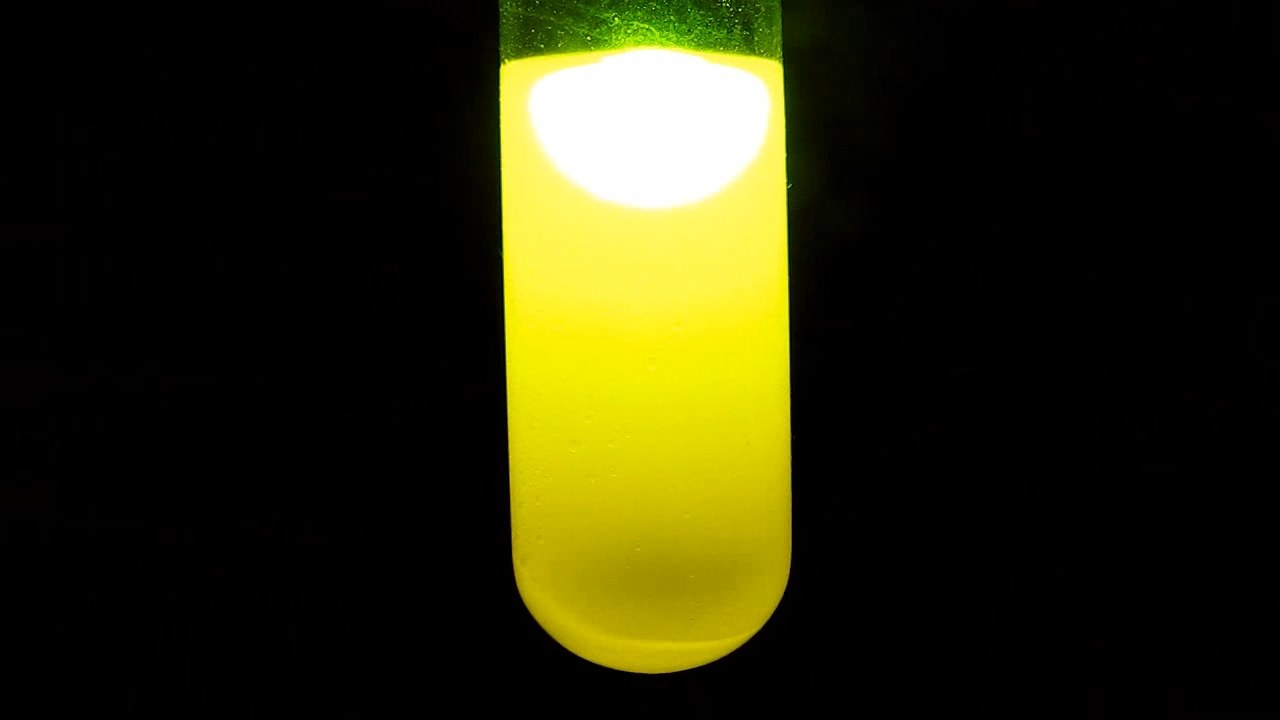
|

|
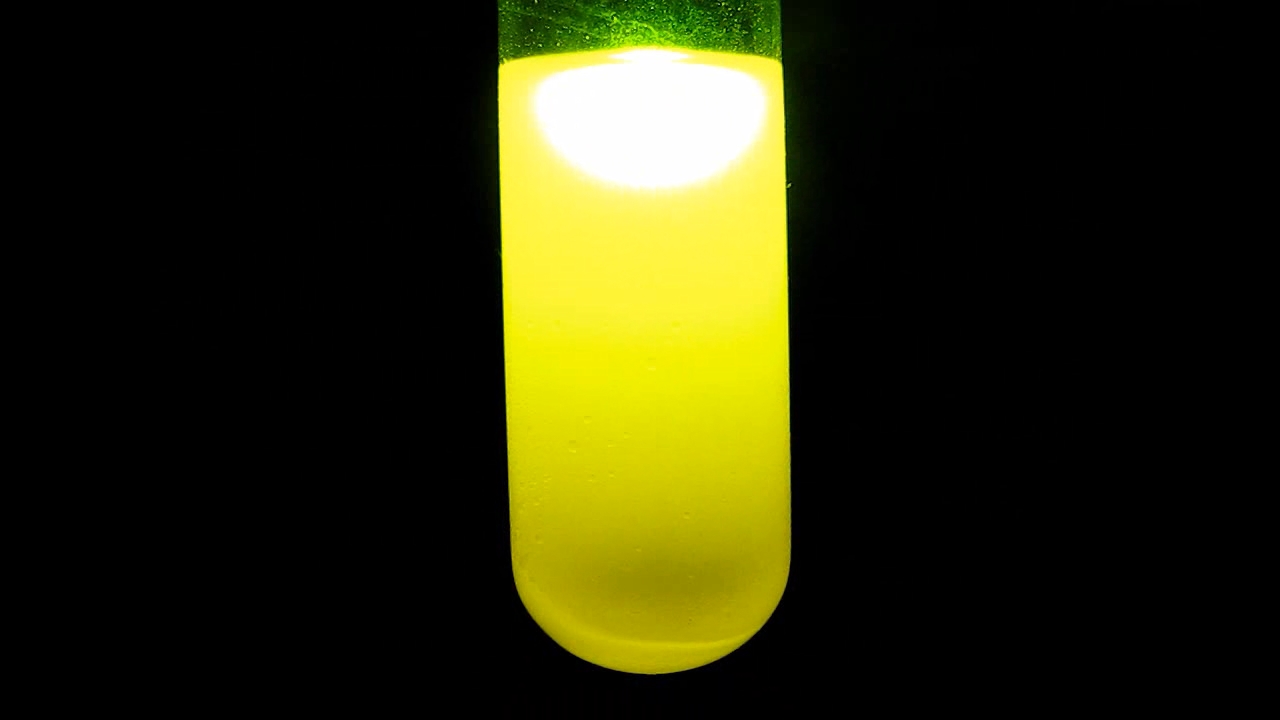
|

|
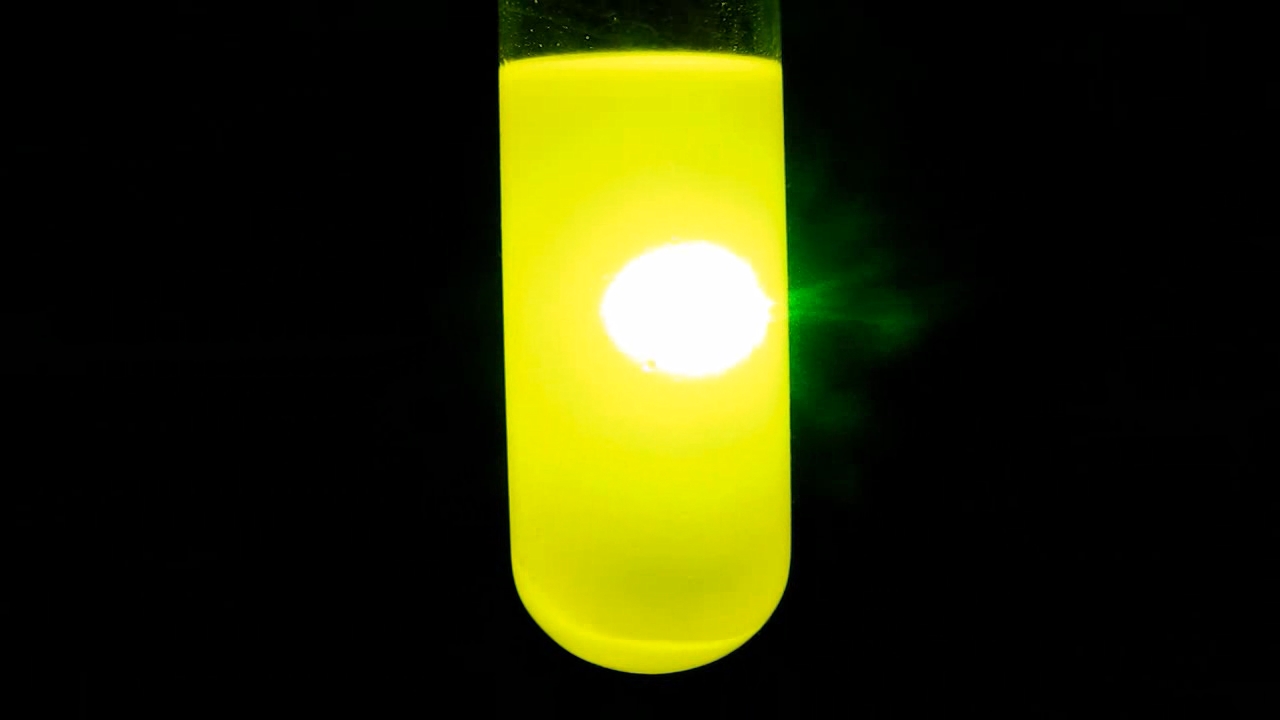
|
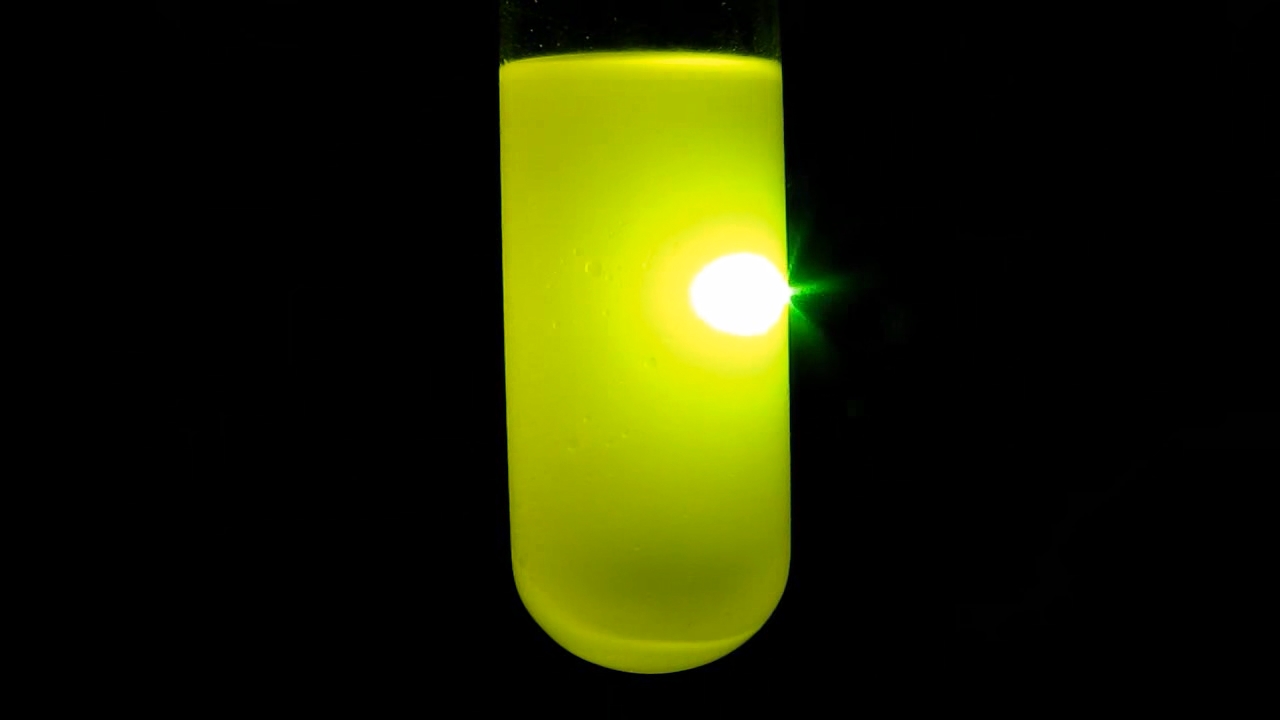
|

|
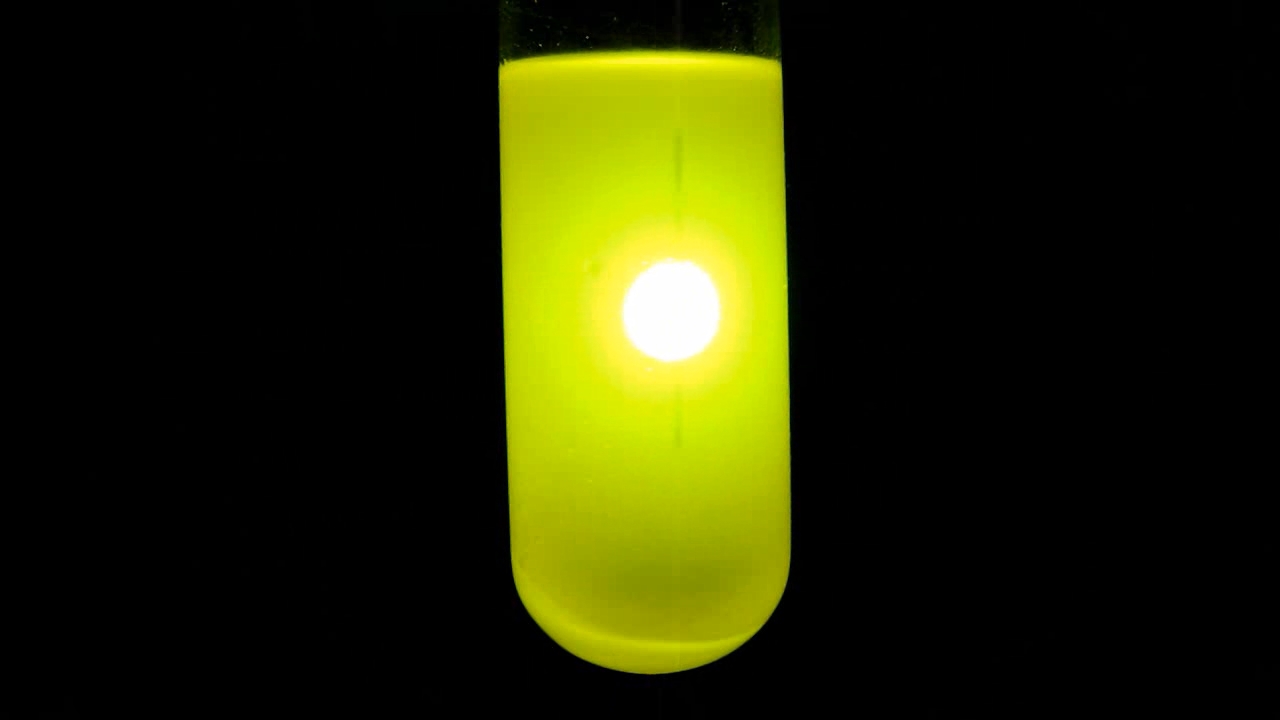
|

|

Rhodamine 6G chloride powder mixed with methanol, emitting yellow light under green laser illumination
Порошок хлорида родамина 6G, смешанный с метанолом, излучает желтый свет при освещении зеленым лазером |

|